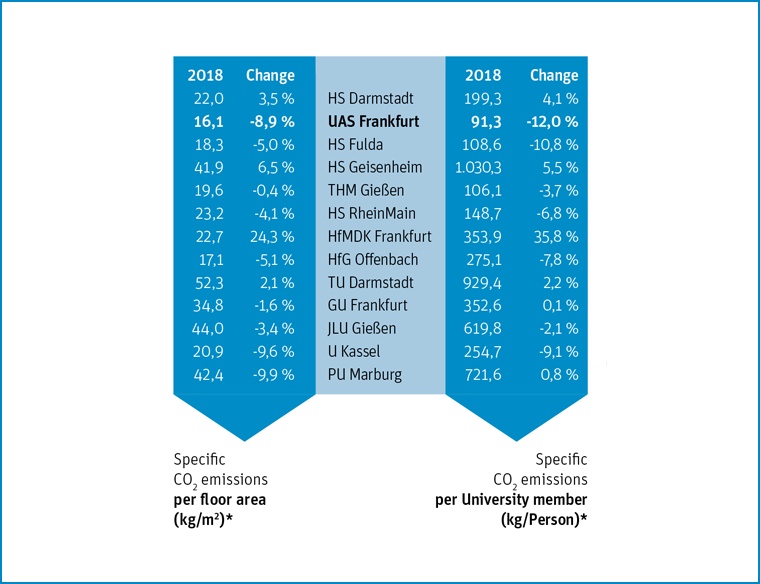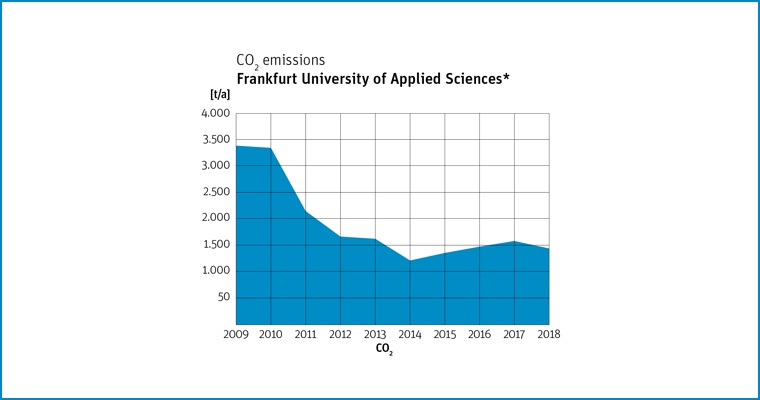CO₂ per Floor Area and per University Member
The target is to make our University carbon-neutral by 2030 – a key aspect to the authentic practice of sustainability in everyday life.
Frankfurt UAS has halved its carbon emissions in the past 10 years; our purchase of green power has propelled us to become the most exemplary University in Hesse in terms of CO₂ emissions.
Within a span of five years (2009-2014), Frankfurt UAS reduced its carbon emissions from roughly 2,500 metric tons/year to approximately 1,000 metric tons/year, corresponding to a 66% reduction. Following a slight increase to 1,500 metric tons, our target over the next 10 years is to reduce this level to reach carbon neutrality.
To date, CO₂ savings have been achieved primarily through external effects – particularly our transition to green power in 2010 and our purchase of district heating in 2019. To meet our ambitious target, we must ensure consistent energy savings and a positive change in mobility behavior going forward. The use of smart thermostats is envisaged with motion sensors that regulate energy consumption depending on room use. A complete reduction in energy consumption will, however, not be possible; accordingly, CO₂ emissions must be compensated for – by planting trees, for example, at our Vietnamese partner university (see page 14 for an overview of measures).
Looking at CO₂ emissions per square meter of floor area Frankfurt UAS, with just under 90,000 m2, stands out among the 13 state universities in Hesse, at an impressive 16.1kg/m2. This is surely also attributable to the fact that Frankfurt UAS has to manage with a comparatively small floor area per University member.
In 2019 we had 15,045 students and 749 staff. Relative to the total number of University members, our University has the lowest carbon emissions, with a specific CO₂ emission rate of 91.3 kg per member of the University.

* Source: Person, Ralf-Dieter: Wöhning, Cord (2020): Hessian universities – use of energy and key indicators. Project activity report of the HIS Institute for Higher Education Development [HIS-Institut für Hochschulentwicklung e. V.]
Sustainable Mobility Management at Frankfurt UAS
Due to the large number of people who commute to campus on a daily basis, be it to work or attend classes, Frankfurt UAS is a major traffic generator in Frankfurt’s North End district. The aim of the project was to evaluate the mobility patterns of staff and students at Frankfurt UAS and to sustainably change their mobility behavior in the long term by establishing a mobility management program and to positively influence the transport choices of staff and students in our progress towards becoming a carbon-free University. The focus here was on electromobility, public transport, cycling, parking management and pedestrian traffic.
A residence analysis, a location analysis and a survey of students and staff were conducted with the aid of various questionnaires. Questions about mobility behavior were likewise included. The surveys were conducted in March 2017 (t(0)) and March 2018 (t(1)).
The 2018 survey showed an 18% increase in public transport usage over the 2017 survey. The modal split of passenger vehicles declined by 15%. This also shows that the absolute number of public transport users rose by 50% over the same period. By contrast, the absolute number of passenger vehicle users was down 40%. Assuming an average 200 working days per year, the transition (from private to public transport) results in annual CO₂ savings of roughly 64,000 kg. With a general average per capita consumption of 8,990 kg CO₂ in Germany (IEA 2015), the savings achieved merely as a result of a change in transport mode for commuting to work correspond to the total annual CO₂ emissions of seven persons.
The “Sustainable Mobility Management at Frankfurt UAS” project has above all strengthened the awareness of students and staff at the University. The greater presence of “mobility” and “sustainability” as thematic areas has enhanced their importance.
The proposed measures, some of which have already been implemented, were primarily deployed in the “Bicycle-friendly employer” certification. The certification also strengthens the profile of Frankfurt UAS as an attractive employer, giving the University a major image boost. Additionally, the project has strengthened the University’s internal research focus on “mobility and logistics.” The measures are also contributing to an increase in energy efficiency and a reduction in emissions levels. This like-wise strengthens our vision of a carbon-neutral University, which is the goal of the sustainability strategy of the State of Hesse.
It is fundamentally important that future measures raise awareness and gain a high level of visibility – visible not only to students, staff and University administration but also to external partners. Accordingly, the visible measures implemented in the area of “mobility” offer the potential to enhance the attractiveness of universities both internally and externally in the social, economic and political arenas.
Text „Sustainable Mobility Management at Frankfurt UAS“ from Lola Freyer


